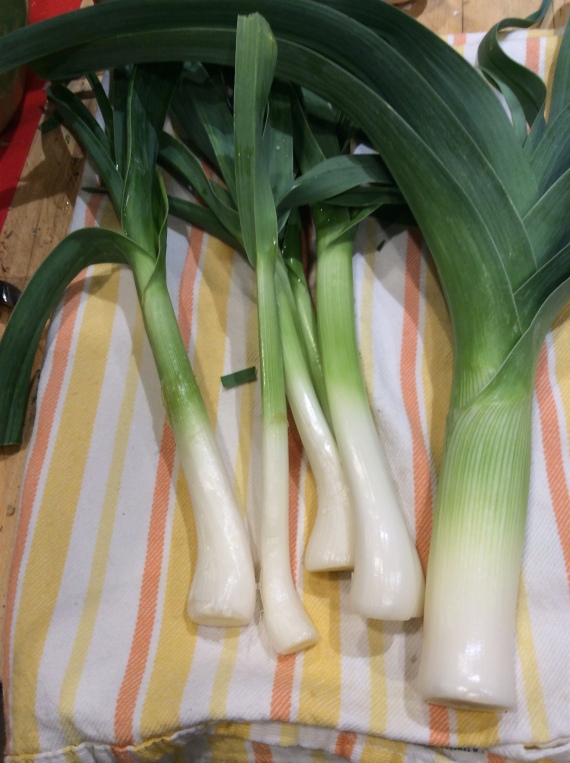Every few years I permit myself to carry a bit about garden produce that is misunderstood. Judging from what I see at farmers markets, green garlic is misunderstood. Because here’s the important thing: green garlic is green. It is bright vibrant green and not yet yellow-green or beginning to yellow, and certainly does not show any garlic scape yet. If the scape has appeared, it is no longer high-quality green garlic, although soon the scape will become a tasty item. Green garlic is very delicious from the time the leaves first show up on the ground to the time that the leaves are large and developed and the stalk is elongating, but even the lowest leaves remain bright green and are not yellowing. For the most part, the white underground shaft will not show enlargement, but might be beginning to swell as you see in the five stalks on the right above. Peel off a couple of lower leaves, cut away the roots, and wash, and it is ready to use. The upper leaves are no longer of culinary interest, but by peeling them off you can get more tender stalk and still use most of the plant.

Now look at the stalk on the left in the top picture. It shows a definite forming bulb, but the leaves are still bright green with no sign of yellowing and there is no scape. It is still usable, and delicious, it is just a little closer to being mature garlic than the others. Your best kitchen knife is an extension of your hand, and will tell you whether it’s still usable. If the skin slices easily and finely without presenting any obstacle to slicing and is not at all papery, you will still enjoy eating it with the rest of the green garlic. Just slice the bulb part thinly and chop it up a bit, skin and all. Garlic is a true nose-to-tail vegetable and you can eat every bit of it, but each part has to be eaten at its proper time.
Green garlic is significantly more delicate than mature garlic, and you can use a lot more of it and achieve a very good flavor without an excessive garlic taste. I used all these stalks to make a pilaf with just over a quart of cooked basmati rice, and the garlic flavor was not at all excessive and the general quality of the pilaf remained sweet. Whatever you use it for, sauté the thinly sliced green garlic in butter or oil for 15 to 20 minutes over fairly low heat, until it is soft and tastes sweet. Watch carefully, because it burns easily, so don’t leave the kitchen. At the end of that time, proceed with your cooking as you usually would.
If you are interested in plant polyphenols, it may interest you to know that the green parts of garlic and the immature skin as shown in the bulb above contain a lot more allicin than the garlic cloves themselves. What this means in practice is anybody’s guess, but since I love green garlic anyway it gives me a good excuse to think that it might also be good for me. If you want to read a bit more about allicin, there are some references here. But please, rather than thinking that any one polyphenol is the answer, eat the widest variety of green vegetables that you possibly can.







